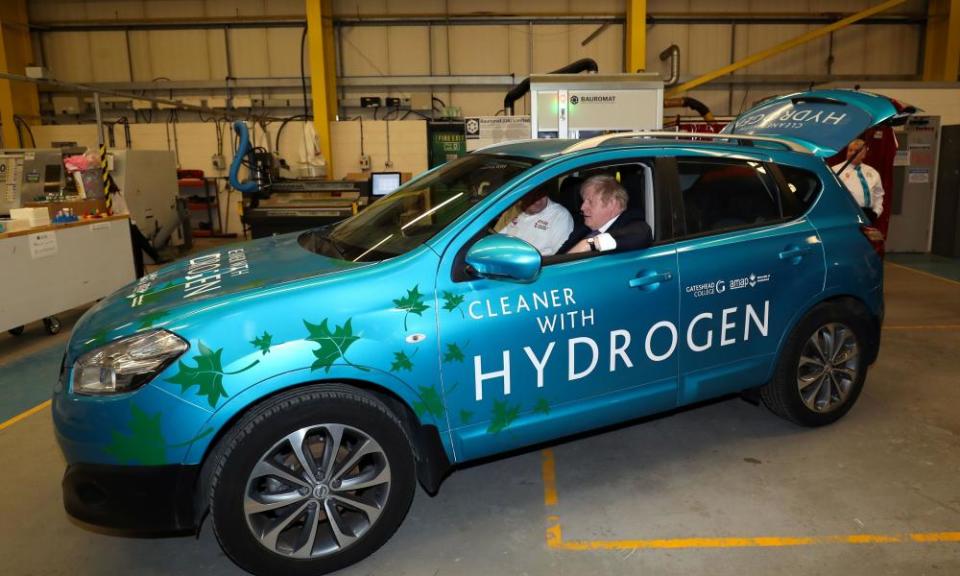Can a hydrogen boom fuel a green recovery for Britain?

At the entrance to Saltend Chemicals Park, on the outskirts of Hull, there is a small blue heritage-style plaque, placed there four years ago by the Royal Society of Chemistry. It proudly commemorates: “100 years of innovation in supplying the UK with transportation fuels and important base chemicals.”
A sense of pride in Saltend’s past is understandable: places like this helped drive Britain’s industrial age. But the biggest, most dramatic innovation of all may be yet to come. This month, the Norwegian energy company, Equinor, (formerly Statoil), unveiled proposals to install the biggest facility in the world for making hydrogen from natural gas, using capture and storage technology to extract and bury the resulting carbon under the North Sea.
The Humber region is currently the biggest emitter of carbon in Britain and the second-highest emitter in Europe. Equinor’s plan, if it goes ahead, would amount to a green revolution at Saltend, allowing businesses on the site to convert to clean energy. And if the rest of the region follows suit, by 2030 this windblown stretch of North Sea coastline could conceivably be one of the world’s leading green energy hubs.
“This is a plan,” suggests Al Cook, the head of Equinor’s English operations, “which would help transform the UK’s largest industrial cluster into its greenest cluster. We are one of the largest energy producers in the world. Saltend is one of the oldest industrial hubs of its kind. Humberside has all the natural resources required on its doorstep. It is a chance for the UK to get on the front foot in the green energy race.”
Get ready for Britain’s hydrogen boom? Definitely maybe.

Hydrogen has been the next big thing for longer than its advocates would care to remember. Before Elon Musk, Tesla and electric battery technology, it was commonly assumed that we might all, one day, be driving hydrogen cars. The traditional drawback for investors has been the expensive complexity of actually producing the stuff. But in an era of net zero carbon emissions targets, the green utility of the most common chemical element in the universe is turning it into one of the most fashionable products on earth.
“Blue” hydrogen – the kind Equinor hopes to produce in Hull – can be made almost carbon-free from natural gas, by using the capture and storage technology. For groups such as Friends of the Earth, “almost” is not good enough, and the enormous cost of capture and storage has also generated scepticism.
Green hydrogen, on the other hand, which is made from renewable sources, bypasses fossil fuels altogether. Both types can be stored and kept in reserve, to be deployed as an inter-seasonal fuel supplementing wind and solar power. Hydrogen, its supporters claim, can also heat homes and workplaces, distributed through the existing infrastructure of the National Grid. It can be used to de-carbonise trains and buses and provide green fuel for heavy-duty vehicles, for which electric-battery technology is impractical. In synthetic form, hydrogen could even help fly zero-carbon planes.
All of which led the European Union’s green deal supremo, Frans Timmermans, to tweet this month: “Hydrogen rocks, and I am committed to making it a success.”
Presenting an EU strategy aimed at producing 10 million tonnes of H2 by 2030, Timmermans said: “The new hydrogen economy can be a growth engine to help overcome the economic damage caused by Covid-19.” Germany has announced a massive £9bn investment plan. Peter Altmaier, the German minister for economic affairs and energy, explained the logic: “In adopting the hydrogen strategy, we are paving the way for Germany to become the world leader in the field of hydrogen technologies.”

In Britain’s energy sector, as other countries invest in the hope of a virtuous cycle of green growth, there is a growing nervousness. Having led the way in early wind farm technology, the UK failed to capitalise and become a major manufacturer and exporter. In the electric car industry, it has fallen far behind Germany and other competitors after failing to invest enough in battery production capacity. Equinor has made it clear that it will only proceed with its blue hydrogen plans for Hull if the government plays its part, sharing the risks of investing in a fledgling industry. “All our experience,” says Cook, “tells us that in projects of this scale and ambition, it only works when governments and companies work together. We will need clear frameworks and assurances and a commitment to investment from London.”
Julia King, Baroness Brown of Cambridge, is the deputy chair of the Committee on Climate Change, and one of the country’s most influential backers of hydrogen. She believes that if Britain acts decisively now, it can take a giant step towards meeting the legal requirement for net zero emissions by 2050 and become a world leader in a lucrative new market. “It is urgent for the UK to get on with this,” said King. “In terms of hydrogen technology, we have a very strong position at the moment. In electrolysis, in storage technology and other areas, we have really dynamic companies which we need to help grow.”
Britain also enjoys a natural advantage, she points out: the winds that blow in from the North Sea and can be turned into green hydrogen. “This country has the best offshore wind resource in Europe. We have all the ingredients to make this an industry which the UK is really successful at; one which will reduce our emissions and which will provide real export opportunities for cutting-edge technologies.
“We could also be selling into a huge export market for hydrogen. We could even get to the position of being sellers of electrolytic hydrogen to Germany.”
We need the government to form a hydrogen industry council to bring the demand and supply side players together
Julia King, the Committee on Climate Change
None of this is likely to happen, though, without significant government intervention, both to lend confidence and to help shape an industry which, at the moment, barely exists. “The challenge is that we’ve actually got to create both supply and demand,” says King. “There’s no point in producing hydrogen unless you have a way of using it. And there’s no point in developing buses, trains and so on unless somebody is going to be able to supply hydrogen to you.
“We need the government to form something like a hydrogen industry council to bring the demand and supply side players together to discuss how to start the industry.
And, obviously, it would be helpful to know that there would be money available. When I was on the board of the green investment bank, one of the things we saw was the confidence that government gave when it came to investing in early offshore wind. Having government as the lead investor brings in other investors.”
Conservative governments are generally averse to a hands-on approach to industrial strategy. With hydrogen, it might be different. Potentially, this is a red wall success story in the making. As King points out: “A successful hydrogen strategy would not be about jobs in Oxford, Cambridge and London. It would be about developing the regions where we bring energy from wind onshore; about places like Hull and Grimsby and all the other places along the coast that have had a really rough time and are in desperate need of an uplift.”
After Equinor unveiled its proposals for Saltend, the headline in the Hull Daily Mail read: “Humber hydrogen plant could create 5,000 jobs.” Further up the north-east coast, the Conservative mayor of Tees Valley, Ben Houchen, has led a successful bid for a £1.3m grant to build refuelling stations for hydrogen vehicles. Following last December’s unprecedented string of victories in Labour strongholds, Conservative MPs are now installed in five of the eight seats in the Tees Valley. Houchen has called for the region to be turned into a UK hydrogen powerhouse.

The new network of influence is making its presence felt in parliament. One of the refuelling stations will be in Redcar, a seat won for the first time for the Conservatives last December by Jacob Young. Young is the chair of the cross-party MPs working group on hydrogen which was set up in 2018. Alexander Stafford, the MP for Rother Valley – where the Battle of Orgreave took place during the miners’ strike – is another hydrogen advocate.
“It would be a great thing,” said Stafford, who sits on the Business, Energy and Industrial Strategy select committee, “if the areas which played such a big part in energy production in the industrial age could now play a new role in producing the energy of the future.”
In its latest report, the group calls for the government to urgently set out a national hydrogen strategy, “or risk falling behind”. Given the huge lead enjoyed by countries such as Germany and Japan in electric battery production, says Stafford, “if you are looking to invest, it is far better to look in the direction of hydrogen than at batteries. The whole world is heading towards becoming carbon neutral, with some countries moving quicker than others. So the question is, how can the UK get on the front foot with hydrogen? If it can do so, there will be enormous dividends.”
According to King, positive signals have come from the minister for business, energy and industrial strategy, Kwasi Kwarteng. King is hopeful that a strategy will be unveiled before parliament goes into recess at the end of July. “There’s much more agreement now about where hydrogen will play a role,” she says. “In the past, it started out mainly being about light-duty vehicles. It is understood now that hydrogen is about trains, buses, industrial processes and so on.”

The stakes could scarcely be higher. Given its lacklustre performance in wind and batteries, if Britain is to emerge from the Covid-19 crisis into a meaningful green recovery that generates growth, hydrogen could be key. The Committee for Climate Change has estimated that a developed hydrogen system could eventually contribute a similar amount of energy to the UK economy as the electricity industry does today. The EU envisions 25% of energy coming from hydrogen by 2050. As governments take the plunge, private investors are placing their bets. The share price of the Sheffield firm, ITM Power, which produces green hydrogen technology, has risen by 1,500% in just over a year.
In places like Hull, the green future can’t come soon enough. A few days after Equinor made its pitch on Saltend, a Social Market Foundation study placed the city at the top of the list of places that will find it hardest to bounce back from the economic crisis caused by Covid-19. Mike Ross, now a Lib Dem councillor, came to the city 20 years ago as a student. He has banged the drum for green investment in Hull for years. “We became the forgotten city of the floods in 2007. Then there was the crash, and then 10 years of austerity which hit places like this hardest. After Covid, there must be a special effort. This city must not be forgotten about again.”
If Hull really does become a vanguard city in a hydrogen revolution, it won’t be.

 Yahoo News
Yahoo News 
